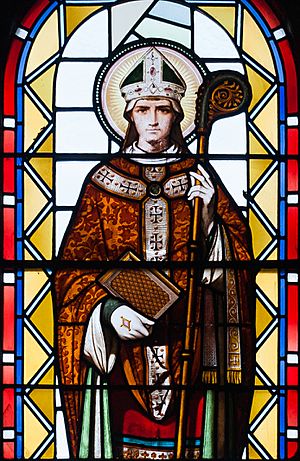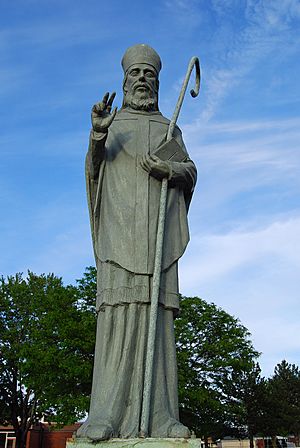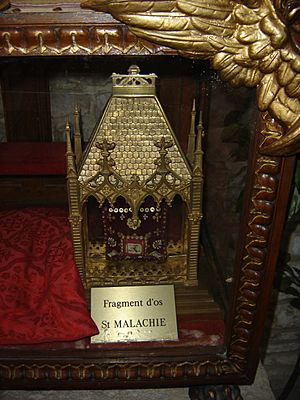Saint Malachy facts for kids
Quick facts for kids Máel Máedóc Ua Morgair |
|
|---|---|
| Archbishop of Armagh | |

Saint Malachy pictured in a stained glass window, Sligo Cathedral of the Immaculate Conception
|
|
| See | Archdiocese of Armagh |
| In Office | 1132–1136/37 |
| Predecessor | Celsus |
| Successor | Gelasius |
| Orders | |
| Consecration | 1124 |
| Personal details | |
| Born | 1094 Armagh, Airgíalla, Ireland |
| Died | 2 November 1148 Clairvaux, Champagne, France |
| Previous post | Bishop of Down (1124–1148) and Bishop of Connor (1124–1136/37) Abbot of Bangor |
Saint Malachy (born Máel Máedóc Ua Morgair) was an important Irish saint. He lived from 1094 to 1148. He became the Archbishop of Armagh, which is a very high position in the Catholic Church in Ireland.
People believed he performed many miracles. He was also linked to a famous, but likely untrue, prediction about future popes. This prediction is called the "Prophecy of the Popes." Malachy was the first person born in Ireland to be officially recognized as a saint. His brother, Gilla Críst Ua Morgair, also became a bishop.
Contents
Malachy's Early Life and Training
Máel Máedóc Ua Morgair, later known as Malachy, was born in Armagh, Ireland, in 1094. He came from a noble family. He was named Máel Máedóc, which means 'servant of Máedóc'. This name was later changed to Malachus in Latin, and then Malachy in English.
He studied under a famous teacher named Imhar O'Hagan. Imhar was a recluse, meaning he lived a quiet, religious life away from others. He also wanted to improve the Irish church. Malachy learned these ideas from him.
After many years of study, Malachy became a priest in 1119. This was done by Cellach of Armagh, who was the Archbishop at the time.
Malachy's First Job in Armagh
Soon after becoming a priest, Cellach made Malachy his assistant. For about two years, Malachy helped manage the church in Armagh. He worked to bring the church's rules and practices in line with those in Rome.
He taught people new ways of singing church services. He also introduced new ways for people to confess their sins, be confirmed, and get married. Many people in Armagh did not know about these practices.
With Cellach's permission, Malachy went to study more. He learned from Máel Ísu Ua hAinmere, who was a former archbishop. Malachy spent three years learning from him in Lismore.
Becoming Abbot and Bishop
In 1123, the leader of Bangor Abbey died. Bangor Abbey was a very important religious place in northern Ireland. Malachy's uncle became the new leader, but he wanted Malachy to take over instead.
So, Malachy became the Abbot of Bangor Abbey. This was a chance to set up a new church area, called the diocese of Connor. In 1124, Malachy traveled to Bangor. He was made the abbot and then a bishop by Cellach.
Malachy Becomes Archbishop of Armagh
In 1132, Malachy was chosen to be the Primate of Armagh. This meant he was the most important church leader in Ireland.
A writer named Bernard of Clairvaux wrote a lot about Malachy. Bernard said Malachy was very dedicated to his religion. In 1127, Malachy visited Lismore again. He also helped Cormac MacCarthy, who was a prince.
While he was Bishop of Down and Connor, Malachy lived at Bangor. When some local princes attacked the areas of Down and Connor, Malachy moved the monks from Bangor to Iveragh in County Kerry. King Cormac welcomed them there.
When Cellach died in 1129, Malachy was chosen to be the Archbishop of Armagh. He did not want this job, but he accepted it. It took him two years to actually take his position. He even had to buy a special staff, the Bachal Isu, from another person who was trying to take his place.
Malachy's Reforms and Retirement
Malachy worked hard to improve the church in Ireland. Bernard of Clairvaux wrote that Malachy brought back proper church rules. He made sure the Roman Liturgy (church services) was used. He also brought back marriage, confession, and confirmation. He introduced Roman chants into the services.
Malachy was also known for helping people in need. He was said to perform miracles and heal the sick. During a time of hunger, he planted apple trees all over Ireland.
After making many changes and seeing things become peaceful, Malachy wanted to rest. So, in 1136 or 1137, he gave up his positions as Archbishop of Armagh and Bishop of Connor. He kept the title of Bishop of Down. He then started a new religious community in Downpatrick.
Journeys and Death
In 1139, Malachy traveled to Rome. He went through Scotland, England, and France. On his way, he visited his friend Bernard of Clairvaux at Clairvaux Abbey. In Rome, he asked Pope Innocent II for special cloths called pallia for the Archbishops of Armagh and Cashel. The Pope also made him a special representative for Ireland.
On his way back, he stopped at Clairvaux again. He brought five monks from there to start a new monastery in Ireland. This led to the creation of the important Abbey of Mellifont in 1142.
Malachy started another trip to Rome in 1148. But when he reached Clairvaux, he became sick. He died there on November 2, 1148, in the arms of Bernard.
Becoming a Saint
| Saint Malachy | |
|---|---|
| Canonized | 1190 by Pope Clement III |
| Feast | 3 November |
| Patronage | Archdiocese of Armagh, Diocese of Down and Connor |
Malachy was officially made a saint in 1190 by Pope Clement III. His feast day is celebrated on November 3. This day was chosen so it would not be on the same day as All Souls Day.
Bernard of Clairvaux, who wrote about Malachy's life, said Malachy was known for being gentle, humble, obedient, and modest. He was also very hardworking in his studies. Another saint, Charles Borromeo, praised Malachy for helping the poor and bringing the holy sacraments to everyone.
Malachy in Visio Tnugdali
The book Visio Tnugdali, written around 1149, mentions Malachy. It describes a vision where a man named Tundale sees Saint Patrick and other bishops. Among them, Tundale recognizes four bishops. One of them is Malachy. The book says Malachy "gave everything that he had to the poor." It also says he "founded a large number of churches and colleges, as many as forty-four in all."
Malachy's Relics
Malachy's body was buried at Clairvaux Abbey in France, near Bernard of Clairvaux. Over time, his tomb was moved several times. In 1194, some parts of his remains were sent to Ireland. They were placed in Mellifont Abbey and other monasteries.
At Clairvaux, parts of Malachy's arm and skull were put into special containers called reliquaries. His arm was kept in a silver case with jewels. Part of his skull was in a silver bust, also decorated with jewels. During the French Revolution, these containers were destroyed, but the relics themselves were saved.
Today, Malachy's head is kept in a reliquary at Troyes Cathedral in France. This is not far from where Clairvaux Abbey used to be.
Places Named After Malachy

Saint Malachy is the patron saint of the Roman Catholic Archdiocese of Armagh and the Diocese of Down and Connor. The Carlingford Abbey was dedicated to him.
Saint Malachy's Church, Belfast was meant to be a large cathedral honoring him. However, the Irish Famine happened, and the money was used to help people in need instead.
Many churches and parishes around the world are named after Saint Malachy. These include churches in places like Tehachapi, California; Brownsburg, Indiana; Burlington, Massachusetts; New York City; Philadelphia, Pennsylvania; Geneseo, Illinois; and Rantoul, Illinois.
The Prophecy of the Popes
A famous "Prophecy of the Popes" is said to have come from Malachy. This prophecy claims to predict that there would only be 112 more popes before the end of the world. A monk named Arnold de Wyon found and published this prophecy in 1590.
However, most experts today believe this document is a trick from the 16th century. They think it was created to help a certain cardinal get elected as pope. Many scholars, like James Weiss and Thomas Groome, agree that it's just an old story and not a real prophecy.
Images for kids
See also
 In Spanish: Malaquías de Armagh para niños
In Spanish: Malaquías de Armagh para niños
- Vaticinia Nostradami
- Saint Malachy's Church, Belfast
- Prophecy of the Popes





